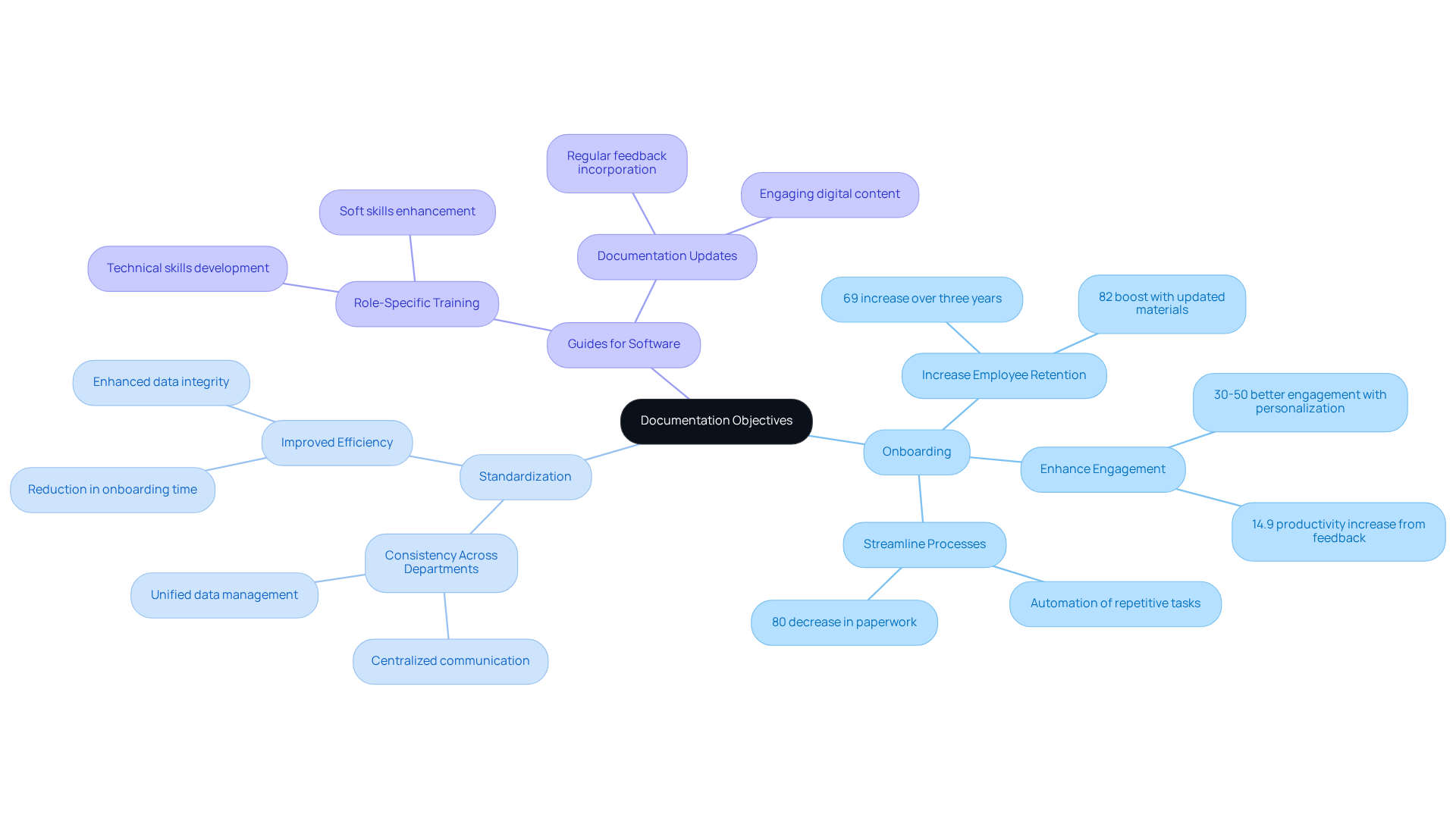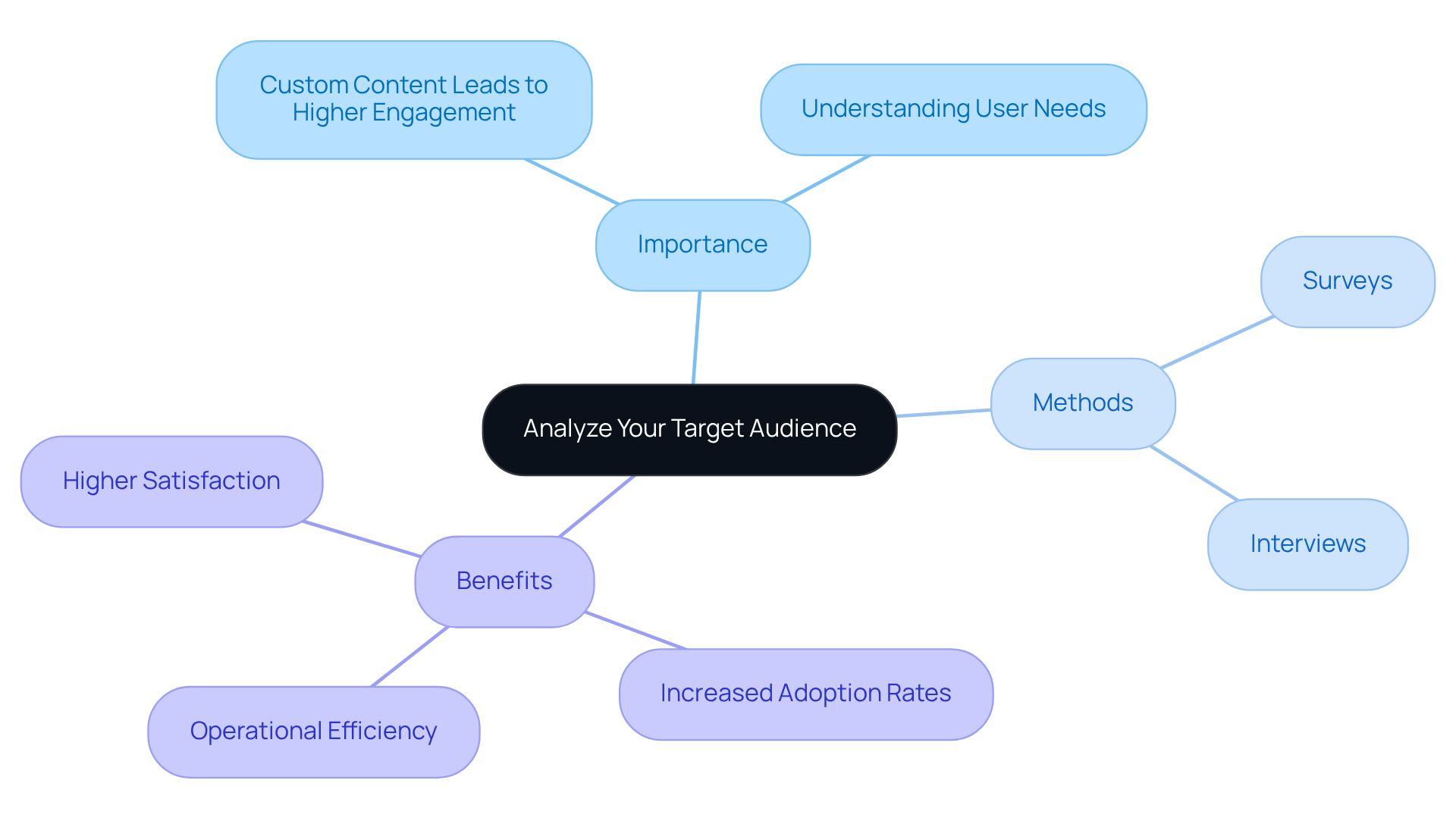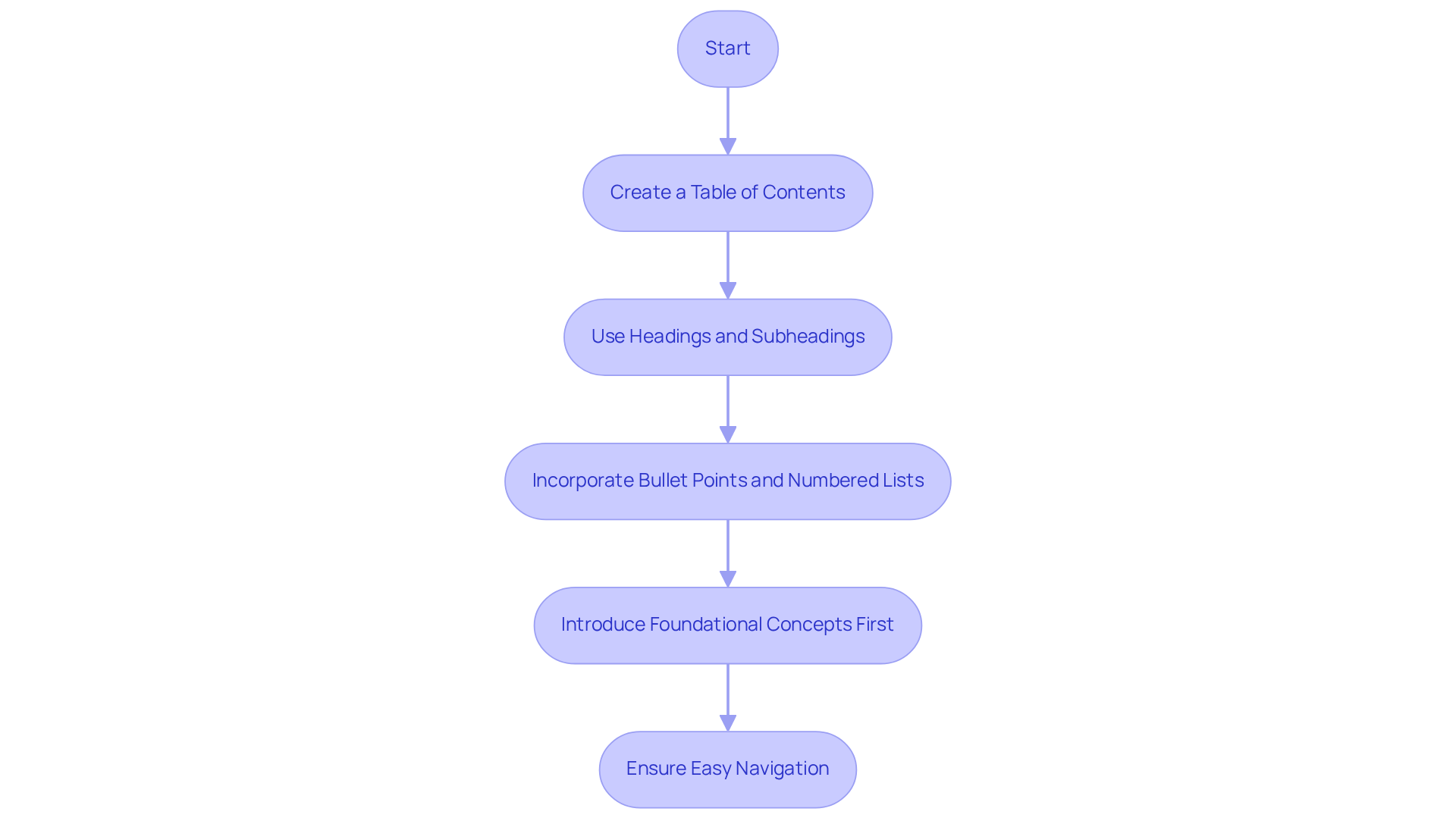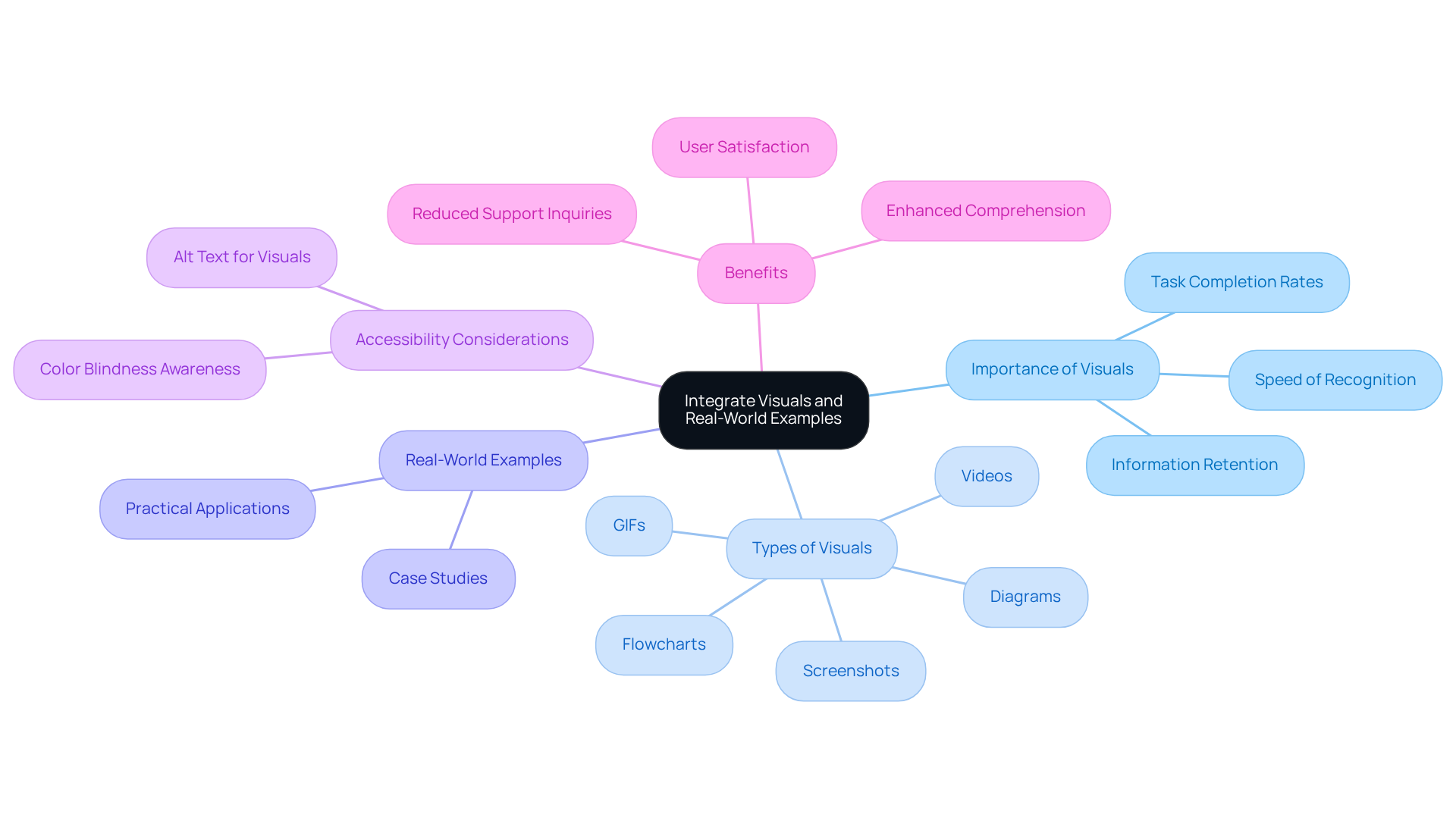
Process Improvement through Documentation
|
October 16, 2025
|
5 Best Practices for Creating a Step-by-Step List in Documentation
Overview
You might be wondering how to create a step-by-step list in your documentation that really works. Well, this article shares five best practices that can help!
- Set clear goals. You want to know what you’re aiming for, right?
- Understand your target audience. After all, you’re writing for them!
- Organize your content for clarity. This makes it easier for everyone to follow along.
- Integrate visuals. Including images or diagrams can really enhance your documentation and make it more engaging.
- Establish a review process. It’s like having a safety net to catch any oversights before your documentation goes live.
These practices are backed by evidence showing that targeted documentation can significantly boost user engagement, improve task completion rates, and encourage continuous improvement. So, if you’re looking to make your documentation more effective and efficient, these tips are definitely worth considering!
Key Highlights:
- Setting clear documentation goals is crucial for creating relevant materials tailored to specific needs.
- Organised onboarding systems can increase employee retention by 69% over three years.
- Understanding the target audience is essential for creating engaging and effective documentation.
- Customised content can boost adoption rates by up to 30%.
- A clear table of contents and structured headings improve content navigation and comprehension.
- Visuals like diagrams and screenshots enhance understanding and can increase task completion efficiency by 67%.
- Establishing a structured review process helps maintain the accuracy and relevance of documentation.
- Incorporating user feedback and peer reviews fosters continuous improvement in documentation quality.
Introduction
Creating effective documentation is super important for any successful organization, right? Yet, many of us find it tough to nail down the art of crafting clear and engaging content. You might be wondering, how can we really enhance user comprehension and streamline processes?
Well, by implementing some best practices for creating step-by-step lists, teams can make a big difference. But with so many factors to think about—like defining objectives, understanding your audience, and integrating visuals—how do you ensure that your documentation not only hits its targets but also connects with users?
This article dives into some essential strategies that can help you elevate your documentation game and foster a culture of continuous improvement. Now, let’s explore how you can make your documentation more effective!
Define Your Documentation Objectives
Setting clear goals for your records is super important before diving into any project involving written materials. You might be wondering why that is! Well, whether you’re looking to bring new staff on board, standardize your methods, or whip up guides for software, having those clear goals helps create materials that meet your unique needs. For instance, if the aim is to streamline onboarding, developing comprehensive guides that cover essential company policies and procedures becomes a top priority. This targeted approach not only makes the materials more relevant but also boosts user engagement and comprehension.
Speaking of engagement, did you know that organized onboarding systems can lead to a whopping 69% increase in employee retention over three years? That really highlights how crucial it is to have clarity when outlining your goals. Plus, organizations that keep their onboarding materials fresh see an 82% boost in retention and a 70% jump in productivity. By aligning your records with clear objectives, you can create a more efficient and cohesive work environment. This ultimately cuts down on confusion and enhances overall operational effectiveness. So, what are you waiting for? Let’s get those goals set!

Analyze Your Target Audience
You might be wondering why recognizing and examining your target audience is so crucial in the recording process. Well, understanding who will use your materials and what their specific needs are is essential. For instance, technical manuals for software developers require a different approach compared to guides meant for end clients. Have you ever thought about how conducting surveys or interviews could provide valuable insights into your audience's preferences, knowledge levels, and challenges? This information is key to creating material that’s not just relevant but also engaging and easy to digest.
Now, let’s dive into how adapting your materials to meet audience needs can really boost satisfaction. Studies show that well-customized content can lead to adoption rates increasing by up to 30%. Isn’t that impressive? Successful case studies reveal that organizations that focus on understanding their audience tend to enjoy higher engagement and shorter training durations. Ultimately, by recognizing and addressing the unique needs of various user groups, you can promote a more effective information strategy, which leads to greater overall satisfaction and operational efficiency.

Organize Content for Clarity and Flow
You might be wondering how to develop a step-by-step list to make your documentation truly efficient. Well, it all starts with a clear table of contents! Think of it as your step-by-step list, which guides readers through the main sections and subsections. By using headings and subheadings, you can help folks navigate the material with ease. And hey, incorporating bullet points and numbered lists? That’s a game changer! It breaks down information into bite-sized, digestible pieces.
Now, let’s talk about the flow of information. It’s super important to introduce foundational concepts before diving into the more complex stuff. This organized approach, which can be outlined as a step-by-step list, not only helps with understanding but also makes it easier for people to find what they need quickly—no one likes feeling frustrated while searching for information!
Speaking of solutions, have you checked out SowFlow's immediate record-keeping? You can create and update guides effortlessly, keeping your material relevant in this ever-changing business world. Plus, research shows that well-structured content really boosts comprehension rates. So, let’s make effective records a priority!

Integrate Visuals and Real-World Examples
You might be wondering how to make your written materials stand out. Well, incorporating visuals like diagrams, screenshots, and flowcharts can significantly boost their effectiveness! Visual aids help clarify complex ideas and serve as quick references, making it easier for everyone to grasp the content. Did you know that studies show individuals complete tasks 67% more effectively when visuals are included? That really highlights their importance, especially in technical documents.
Speaking of speed, our brains can recognize an image in just 13 milliseconds! That’s lightning-fast compared to reading text. Plus, integrating real-world examples or case studies can show how documented processes play out in practical situations. For instance, when you're documenting a software feature, including a screenshot of the feature in action provides context that words alone might miss. This mix of visuals and examples not only makes your material more engaging but also helps with information retention.
Now, let’s talk about accessibility. It’s crucial to add considerations like alt text for every visual, ensuring that everyone, including those with visual impairments, can use your materials. By effectively keeping records with visuals, you can enhance user satisfaction and reduce support inquiries, ultimately creating a more efficient operational environment. So, why not give it a try?

Establish a Review and Update Process
To keep your records effective, you might be wondering how to set up a structured review and update process. Here are some key steps to consider:
- Designate Responsibilities: It’s a good idea to assign specific team members to be in charge of content reviews.
- Establish a Schedule: Think about creating a timeline for periodic evaluations—maybe quarterly or bi-annually, depending on what your documentation needs.
- Conduct Reviews: During these evaluations, take a critical look at the relevance and accuracy of the information. Make sure to update anything that reflects changes in procedures or policies.
- Seek Feedback: Actively gathering feedback from users can help you spot areas that need improvement.
- Incorporate Peer Reviews: Don’t forget to utilize peer reviews within your teams; it’s a great way to catch errors that the original author might have missed.
- Leverage Technology: Have you thought about using AI tools like PDFGPT? They can really streamline the review process and make it more efficient.
This proactive maintenance approach not only keeps your content current but also creates a step-by-step list that fosters a culture of continuous improvement within your organization. It’s all about enhancing overall operational efficiency. As Utsav Prajapati points out, 'One mistake can equate to lost revenue, lawsuits, or missed opportunities,' which really highlights the importance of accuracy in documentation. And let’s not forget what Anastasia Masadi, a Product Owner, has to say: 'SowFlow has been a game changer in the way we document work and deliver to our clients. I do not have to take each screenshot separately and do not even have to leave the browser while I am creating SOPs and training materials. SowFlow gave me time from my life back.' This really shows how SowFlow enhances efficiency and streamlines SOP creation for teams.

Conclusion
Creating effective documentation is a multifaceted process that requires careful consideration of objectives, audience needs, content organization, visual aids, and ongoing maintenance. You might be wondering how to prioritize clear goals. By doing so, organizations can tailor their materials to serve specific purposes, whether for onboarding new employees or standardizing procedures. This clarity not only enhances user engagement but also significantly improves retention and productivity.
Key practices to consider include:
- Analyzing your target audience to ensure the content resonates with them
- Organizing information for clarity and ease of navigation
- Integrating visuals to aid comprehension
Now, let’s dive into why establishing a structured review and update process is vital for keeping your documentation accurate and relevant over time. These steps collectively foster a culture of continuous improvement, ensuring that your documentation evolves alongside your organizational needs.
Ultimately, the significance of well-crafted documentation cannot be overstated. It serves as a foundational element for operational efficiency, employee satisfaction, and knowledge retention. By implementing these best practices, organizations can create step-by-step instructions that not only guide users effectively but also contribute to a more knowledgeable and engaged workforce. Embracing these strategies isn’t just beneficial; it’s essential for success in today’s dynamic business environment.
Frequently Asked Questions
Why is it important to define documentation objectives before starting a project?
Defining clear documentation objectives helps create materials that meet specific needs, such as onboarding new staff or standardizing methods. This targeted approach increases relevance, user engagement, and comprehension.
How does organized onboarding impact employee retention?
Organized onboarding systems can lead to a 69% increase in employee retention over three years. Keeping onboarding materials fresh can further boost retention by 82% and productivity by 70%.
What should be considered when analyzing your target audience for documentation?
It is crucial to understand who will use the materials and their specific needs. Different audiences, like software developers versus end clients, require different approaches in documentation.
How can conducting surveys or interviews benefit the documentation process?
Surveys and interviews can provide valuable insights into the audience's preferences, knowledge levels, and challenges, which helps create materials that are relevant, engaging, and easy to digest.
What are the benefits of customizing content for different user groups?
Well-customized content can lead to adoption rates increasing by up to 30%. Organizations that focus on understanding their audience tend to experience higher engagement and shorter training durations.
What is the overall impact of recognizing and addressing audience needs in documentation?
By addressing the unique needs of various user groups, organizations can promote a more effective information strategy, leading to greater overall satisfaction and operational efficiency.
👍
What others are liking
5 Steps to outline your ideal documentation structure
5 MINS READ
Where to start the your journey of mapping out your ideal documentation structure, aligning it with the very heartbeat of your organization?
Defining a winning level of detail in your process
3 MINS READ
What is too much detail, and what is too little? This article described in that winning level detail about what detail is enough.





